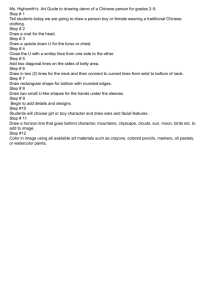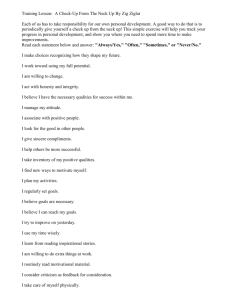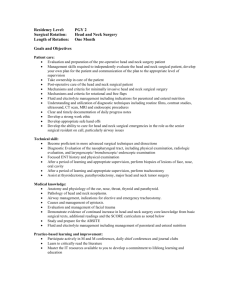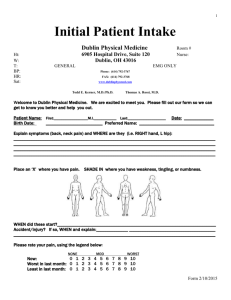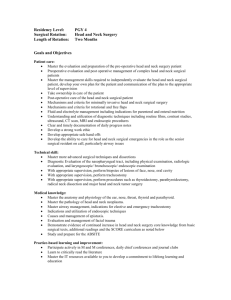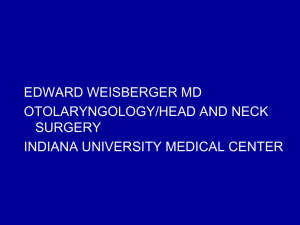Slide 1 - Johns Hopkins Medicine
advertisement
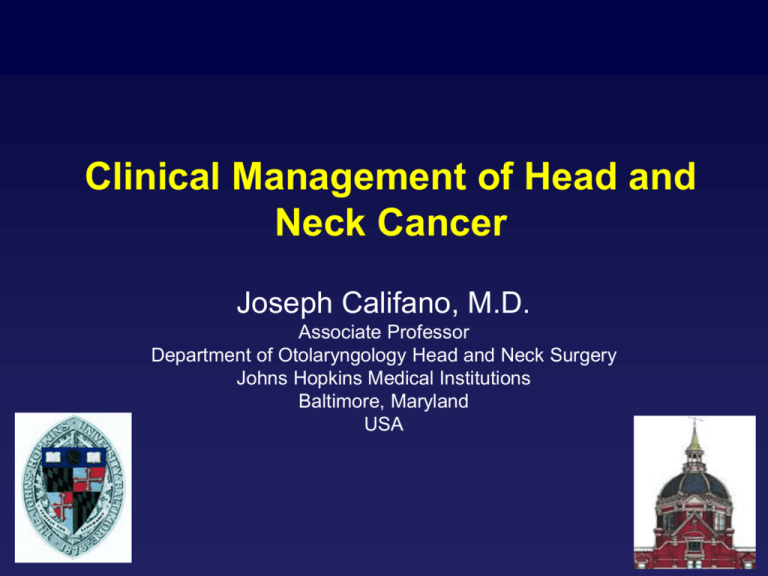
Clinical Management of Head and Neck Cancer Joseph Califano, M.D. Associate Professor Department of Otolaryngology Head and Neck Surgery Johns Hopkins Medical Institutions Baltimore, Maryland USA Normal Oral Cavity Tongue cancer What is Head and Neck Cancer • Cancer of the nose, mouth, lips, gums, tongue, throat, voicebox and other sites • Affects 50,000 people in the US each year • Curable 50% of the time What causes head and neck cancer? 1) Smoking 2) Smoking 3) Tobacco and smoking 4) Alcohol 5) sexually transmitted virus (HPV 16), Environmental, hereditary How To Treat Head and Neck Cancer • Find it, usually late -over 80% of tumors are late stage • • • • Surgery (cut it out) Radiation (burn it) Chemotherapy (selective poisoning) Combine the above The Key to Curing Cancer • Stop all smoking (causes more cancer deaths than any other factor) • Wait 30 years (time required for relative risk of lung cancer to return to 1 after smoking cessation) • Ignore cancers due to: – Low level exposures – Multifactorial genetic predisposition – Stochastic phenomena Other Ways to Cure Cancer • Prevention – definition of more subtle genetic and environmental risk factors • Targeted Therapy – Molecular and otherwise • Screening – Molecular Screening for early disease – Genetic screening for inherited cancer susceptibility – Conventional screening for non-genetic risk factors • Pap smear, colonoscopy, etc Premalignant changes Advanced Oral Cavity Squamous Cell Carcinoma • Definition of advanced oral cavity carcinoma • Historical data regarding therapy – Surgical vs. radiotherapy • • • • • Surgical approaches Combined modality therapy Therapy for advanced neck metastasis Future therapies Case Studies UICC/AJCC Staging for Advanced Oral Cavity Cancer • Big Tumor • T3-4, any N – T3 > 4cm – T4a invasion of adjacent structures, cortical bone, deep tongue muscles, maxillary sinus, skin – T4b “unresectable” invasion of masticator space, pterygoid plates, skull base, or carotid encasement UICC/AJCC Staging for Advanced Oral Cavity Cancer • Small Tumor with neck metastasis – T1-T2, N2-3 – Tumor < 4 cm with 2 or more cervical metastasis, one or more contralateral cervical metastases, or cervical metastasis > 3cm Primary Surgery + Radiation Indicated for Advanced Oral Cavity Cancer • Low local control for primary radiotherapy for advanced oral cavity (30-40%) and poor survival (25%) • Increased local control with surgery + radiotherapy (60%) and improved survival (55%) – Zelefsky et al, Head Neck. 1990 Nov-Dec;12(6):470-5 • Local control significantly improved for locally advanced T3, T4 oral cancers using surgery + postoperative radiotherapy vs. primary RT – Fein et al. Head Neck. 1994 Jul-Aug;16(4):358-65 Surgical Approaches • • • • Transoral Visor Lip Split with or without mandibulotomy Lip Split with Mandibulectomy Surgical Approaches • Transoral and Visor Approaches – Cosmetic but may limit exposure • Lip Splitting – Modest cosmetic disadvantage with excellent posterior exposure for mandibulotomy • Paramedian or midline mandibulotomy – Avoidance of alveolar nerve Surgical Approaches Caveats • Approach determined before incision and mandibulectomy or mandibulotomy – Accurate assessment of bone erosion, involvement of neural structures Surgical Resection Advances • Reconstruction • Reconstruction • Free Tissue Transfer – Mandibular reconstruction (fibula, scapula, etc.) – Soft tissue/tongue (radial forearm, rectus abdominus, lateral thigh, etc.) • Resection is rarely limited by size or extent of tumor Contraindications to Resection T4b: invasion of masticator space, pterygoid plates, skull base, or carotid encasement Patient perception of quality of life Primary Surgical Therapy Followed by Postoperative Chemotherapy and Radiation I: EORTC Bernier et al. NEJM 2004 • Previously untreated SCC, all head and neck sites, n=167, 5 year median follow up • 100 mg/m2 cisplatinum day 1, 22, 43 during postoperative irradiation or postoperative radiation alone Primary Surgical Therapy Followed by Postoperative Chemotherapy and Radiation I: EORTC Bernier et al. NEJM 2004 • pT3 or pT4, any N, except T3N0 of the larynx, with negative resection margins • pT1 or T2, N2 or N3 • T1 or T2 and N0 or N1 with pathological extranodal spread, positive resection margins, perineural involvement, or vascular tumor embolism • Oral cavity or oropharyngeal tumors with involved lymph nodes at level IV or V EORTC Bernier et al. NEJM 2004 • The overall survival rate 53% vs 40%, p=0.02 • Locoregional failure 18% vs. 31%, p=0.007 • Severe (grade 3 or higher) adverse effects 41% vs. 21% p=0.001 Postoperative Chemoradiation for Advanced Head and Neck Cancer • Clear advantage in locoregional control • Survival advantage • Difference in enrollment criteria may suggest survival advantage for locally aggressive tumors without significant nodal disease New Trials : Molecular Targeted Therapy, EGF Inhibitors Bonner, et al, NEJM, 2005 Patients randomized Median survival - Two-year survival - Three-year survival Grade 3/4 mucositis Grade 3/4 infusion reaction Grade 3/4 skin reaction Radiation only Cetuximab+RT p-value 213 211 28 mo 55% 44% 54 mo 62% 57% 0.02 (log-rank test) 52% 55% 0.50 (Fisher's exact) - 3% 0.01 (Fisher's exact) 18% 34% 0.0003 (Fisher's exact) Head and Neck Cancer • Multimodality therapy for all but very early stages: surgery, radiation with adjuvant chemotherapy • Significant morbidity due to therapy is possible: cosmesis, decreased saliva, swallowing dysfunction, social dysfunction • Novel molecular directed therapies incorporated into next generation trials Case Presentation I • 73 Y edentulous farmer with a right gingival lesion, otherwise asymptomatic • 120 PY smoking history, currently smoking • Past Medical History: diabetes, coronary artery disease, myocardial infarction x 2, carotid endarterectomy, peripheral vascular disease, and hypertension, renal insufficiency • Exam shows a right lower gingival mass, 2.5 cm squamous cell carcinoma Case Presentation I • CT demonstrates R mandibular invasion Case Presentation I • PET/CT demonstrates no evidence of metastasis • MR angiography demonstrates severe peripheral vascular disease in bilateral lower extremities Case Presentation I Treatment Options • T4N0M0 squamous cell carcinoma of the right alveolus • Right Mandibulectomy (via visor or lip split), right neck dissection, fibula free flap, tracheotomy, postoperative radiation and chemotherapy • Transoral mandiblectomy, postoperative radiation to primary site and ipsilateral neck Case Presentation I Therapy • Resection from paramedian to angle of mandible to encompass alveolar nerve Case Presentation I Outcome • Oral alimentation at 5 days postop • External beam radiation to primary and ipsilateral neck onset 3 weeks post surgery • Acceptable cosmetic appearance • NED at 30 mo, died shortly after from MI Case Presentation II • A 41-year-old traffic manager with a left lateral tongue cancer. • 2 years of leukoplakia with documented high grade dysplasia prior excisions x 3 • Recent 1.5 cm lesion excised, demonstrated squamous cell carcinoma, with a positive deep margin • No history of smoking or ethanol intake Case Presentation II • Exam is unremarkable except for a small lesion on his left lateral/vental tongue Case Presentation II PET/CT results • No uptake in the tongue • Moderate intensity uptake in a level II 9mm lymph node and a 7 mm level posterior IV lymph node • No evidence distant metastasis • Chromosomal breakage study negative Case Presentation II Staging • T1N0M0 SCC left lateral tongue • T1N2bM0 SCC left lateral tongue (by PET) Case Presentation II Treatment • Left partial glossectomy, transoral • Left neck dissection –Level I-V, sparing IJ, SCM, CN XI –Level V included to ensure excision of posterior level IV node found on PET Case Presentation II Surgical Results • 1.5 cm SCC in glossectomy specimen with negative margins • 5/35 lymph nodes + SCC in neck dissection – 2/5 level I lymph nodes + SCC – 3/7 level II lymph node + SCC • pT1N2bM0, Stage IV Case Presentation II Treatment • Left partial glossectomy • Left neck dissection levels I-V • Postoperative EBRT with concomitant cisplatinum days 1, 22,43
